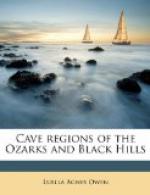As no two of the glorious geysers of the Yellowstone Park are alike, neither do the two great caves of the Hills indicate that they should be so. The vent-tubing of each is quite unlike that of the other in all the essential governing points of length, size, shape, angle of inclination and power-conserving bends. And the differences extend in an almost equally marked degree throughout the vast and complicated succession of storage chambers and their connecting channels. The small vent of Wind Cave shows that the ejected jet was far from being equal to that of the Crystal Cave in volume; but the nearly perpendicular long arm of its tube shows also that its jet attained a much greater height, even supposing that it should be necessary to make some allowance for a short elbow at the top.
Dr. Hayden’s geological party gave much attention to the Yellowstone Park while its wonders were new to the world, and observations were made at various times during the period included between the years 1869 and 1870. The special study, and full report of the geysers became the duty of Dr. A.C. Peal, whose descriptions and conclusions were published in U.S. Geological Survey Report, 1878, Part II. In the final pages of his report he quotes the leading authorities on geyser action, and applies the principles of their theories, according to his own judgment, to the geysers of the park. Since copies of this report are not now easily obtained, nor even always accessible to the increasing number of personages who visit the park, it may be well to quote from him some of the theories he discussed and the opinions he expressed. On page 416, beginning the chapter with the derivation of the word geyser from the Icelandic word geysa—to gush, he continues:
“We now come to the definition of a geyser. It may be defined to be a periodically eruptive or intermittent hot spring, from which the water is projected into the air in a fountain-like column. The analogy between geysers and volcanoes has frequently been noticed and the former have often been described as volcanoes which erupt heated water instead of melted lava. We have italicized the word hot in the definition just given, because springs containing a large amount of gas may simulate geysers.




